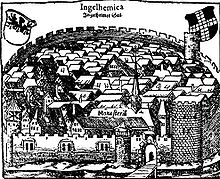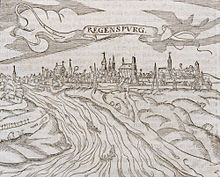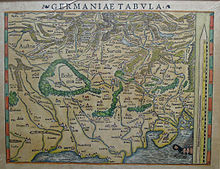Sebastian Munster

Sebastian Münster (born January 20, 1488 in Nieder-Ingelheim , † May 26, 1552 in Basel ) was a cosmographer , humanist and Hebraist .
biography
Sebastian Münster was born on January 20, 1488 in Ingelheim am Rhein; Andreas (Endres) Münster is named as his father, at that time the church caretaker and hospital master of the Heiliggeist hospital there.
education
After studying at the Franciscan School in Heidelberg , he joined the Franciscan Province of Strasbourg in 1505 at the age of 17 . In 1507, the superiors of the order sent the extraordinarily linguistically gifted students to Leuven and Freiburg im Breisgau . During the one-year study visit to Freiburg, his teacher Gregor Reisch , prior of the Charterhouse there , inspired him primarily for Hebrew and geography .
In 1509 Münster went to the Rouffach Monastery , where he became a student of Konrad Pelikan and continued his education in Greek , Hebrew , mathematics , astronomy and geography. He studied the natural sciences after the encyclopedia Margarita philosophica of Gregor Reisch . The reading of Pomponius Melas De chorographia (1st century) also had a lasting influence on Münster.
In 1511 he followed his teacher Pelikan to the University of Basel and later to Pforzheim , where he was ordained a priest in 1512 . Munster and Pelikan extended their studies to other Semitic languages , especially Aramaic and Ethiopian .
Employment as a university professor
From 1514 to 1518 Münster worked as a lecturer at the Franciscan Order College in Tübingen , where he also continued his astrological studies with the famous astronomer Johannes Stöffler , known as the “Father of Science”. From 1518 he taught again at the religious college in Basel and from 1521 to 1529 in Heidelberg, where Elector Ludwig V then appointed him in 1524 as professor of Hebrew at the University of Heidelberg .
In 1529 he resigned from the Franciscan order and followed a call to the University of Basel . There he got caught up in the religious battles between Catholics and Protestants and finally converted to Protestantism. In 1530 he married Anna Selber, the widow of the Basel book printer Adam Petri , in whose office - under the direction of his stepson Heinrich Petri - his main work, Cosmographia , was later to be printed. In 1532 his daughter Aretia was born. Between 1547 and 1548 he was elected rector of the university for one year and at the same time took part in the Reichstag in Augsburg .
Activity as a cosmographer
Freed from everyday worries, Sebastian Münster could now devote himself all the more to the long-planned preparation of geographical works. This was followed by his travels to France and Switzerland, to Swabia and Bavaria, on which he collected further material for depicting the world of that time. Münster had an agreement with more than 100 authors to produce and collect travel reports and location views from all over the world for him. The fact that Johannes Stumpf was working on the publication of the Eydgenossenschektiven (a Swiss reference work) in Zurich prompted Münster to accelerate the completion of the Cosmographia . The first edition of Cosmographia appeared in 1544, the translations, new editions and extensions of which occupied him throughout his life.
In 1547 Münster was appointed rector of the University of Basel. His motto was: "Reverence for God is the beginning of knowledge."
On May 26, 1552 he died of the consequences of the plague . He is referred to as the "German Strabo " on his tomb in Basel Minster .
plant
Main work
His main work, the widely distributed Cosmographia , which has been translated into many languages , was presented by Sebastian Münster in 1544. Münster received the first suggestions for this work as early as 1524 from the Alsatian humanist Beatus Rhenanus . In the preface, Münster emphasizes that he wants to give “a description of the whole world and everything in it” in six books. In fact, the work offers history and geography, astronomy and natural sciences as well as regional and folklore according to the state of knowledge at the time. In the first of the six text books, Münster explains mathematical geography, for example triangulation using a compass and a divided circle. The other five books contain descriptions of different countries based on geographical, historical and cultural-historical notes.
With this, Münster presented the first scientific and at the same time generally understandable description of the world in German, on which he had worked with more than 120 "notables, scholars and artists" in a preparation period of around twenty years.
The editions from 1550 onwards comprise more than 1200 pages and contain 62 maps and 74 cityscapes, including 26 German cities. With these issues of Cosmographia , a new quantitative and qualitative standard was set for the equipment of city books.
Sideline
In addition to his main work, Cosmographia , Sebastian Münster has written more than seventy works, some of them very extensive, in the field of Hebrew studies, natural sciences and geography, but also theology and biblical studies.
Under the title Liber viarum linguae sacrae (1520) he translated the Hebrew grammar of Moses Kimchi . The Latin-Greek-Hebrew dictionary Dictionarium trilingue (1530) and the first Christian Bible edition in Hebrew with a Latin translation (2 volumes, Basel 1534/35), the geographical works Germania descriptio (1530) and preceding Cosmographia (1544) deserve special mention Mappa Europae (1536) and the editions of ancient and contemporary geographers (1538–1540), including above all the Latin translation of Geographia by the Greek naturalist Claudius Ptolemy with 48 maps designed by Sebastian Münster himself (1540).
His late works include the Rudimenta mathematica (1551; digitized version) with theorems on elementary geography and their application for the production of astronomical instruments, as well as the French translation of Cosmographia (1552), which he himself edited .
Portraits by Sebastian Munster

Some oil paintings, woodcuts and copper engravings convey a picture of the personality of Sebastian Münster, including a painting by Hans Holbein the Elder. J. (Basel around 1530), woodcuts in later editions of Cosmographia and copperplate engravings in biographical works of the 17th century. The German edition of Cosmographia from 1615 also contains a copper engraving by Willem de Haen with a portrait. Another portrait shows him as the rector of the University of Basel (based on a painting by Christoph Amberger , around 1547 or 1552) on the front of the 100 DM banknote (reversed there) that was in circulation from 1962 to 1991.
literature
- Karl Heinz Burmeister : Sebastian Münster - attempt of a biographical overall picture . Basel Contributions to History, Volume 91, Basel and Stuttgart 1963 and 1969.
- Karl Heinz Burmeister: Sebastian Münster - A Bibliography . Wiesbaden 1964.
- Hans Georg Wehrens: Freiburg in the "Cosmographia" by Sebastian Münster (1549); in Freiburg im Breisgau 1504–1803, woodcuts and copper engravings . Herder Verlag, Freiburg 2004, p. 34 ff. ISBN 3-451-20633-1 .
- Günther Wessel: From someone who stayed at home to discover the world - The Cosmographia of Sebastian Münster or How one imagined the world 500 years ago . Campus Verlag, Frankfurt 2004, ISBN 3-593-37198-7 .
- Ludwig Geiger : Münster, Sebastian . In: Allgemeine Deutsche Biographie (ADB). Volume 23, Duncker & Humblot, Leipzig 1886, pp. 30-33.
- Claus Priesner : Münster, Sebastian. In: New German Biography (NDB). Volume 18, Duncker & Humblot, Berlin 1997, ISBN 3-428-00199-0 , pp. 539-541 ( digitized version ).
- Werner Raupp : MÜNSTER, Sebastian. In: Biographisch-Bibliographisches Kirchenlexikon (BBKL). Volume 6, Bautz, Herzberg 1993, ISBN 3-88309-044-1 , Sp. 316-326. (with detailed bibliography).
- Kaspar von Greyerz : Münster, Sebastian. In: Historical Lexicon of Switzerland .
Web links
- Literature by and about Sebastian Münster in the catalog of the German National Library
- Works by and about Sebastian Münster in the German Digital Library
- Latin works on the Internet
- Funeral speech by Schreckenfuchs in German translation; with appendix by Ernst Emmerling
- Gabriele Dörflinger: Sebastian Münster . A collection of materials from Historia Mathematica Heidelbergensis . Contains u. a. Portraits by Sebastian Munster .
- Hartmut Geißler: Sebastian Münster - Ingelheim's greatest son Extensive document collection on ingelheimer-geschichte.de, accessed on May 5, 2017
Individual evidence
- ^ Collective of authors: Lexicon of Geosciences , Volume 3, Spectrum Academic Publishing House, Heidelberg, Berlin 2001, ISBN 3-8274-0422-3 , p. 436
- ↑ Ralf Kern: Scientific instruments in their time . Volume 1: From astrolabe to mathematical cutlery . Cologne: Verlag Walther König, 2010. P. 308.
- ↑ According to the inscription on the reverse "Ao 1552", ie in the year of Münster's death. S .: Michaelis, Rainer, SMB-SPK, Ed .: Gemäldegalerie Berlin. 200 masterpieces ..., Berlin 2010, p. 104
| personal data | |
|---|---|
| SURNAME | Münster, Sebastian |
| BRIEF DESCRIPTION | German-Swiss cosmographer and Hebrew |
| DATE OF BIRTH | January 20, 1488 |
| PLACE OF BIRTH | Nieder-Ingelheim |
| DATE OF DEATH | May 26, 1552 |
| Place of death | Basel |



